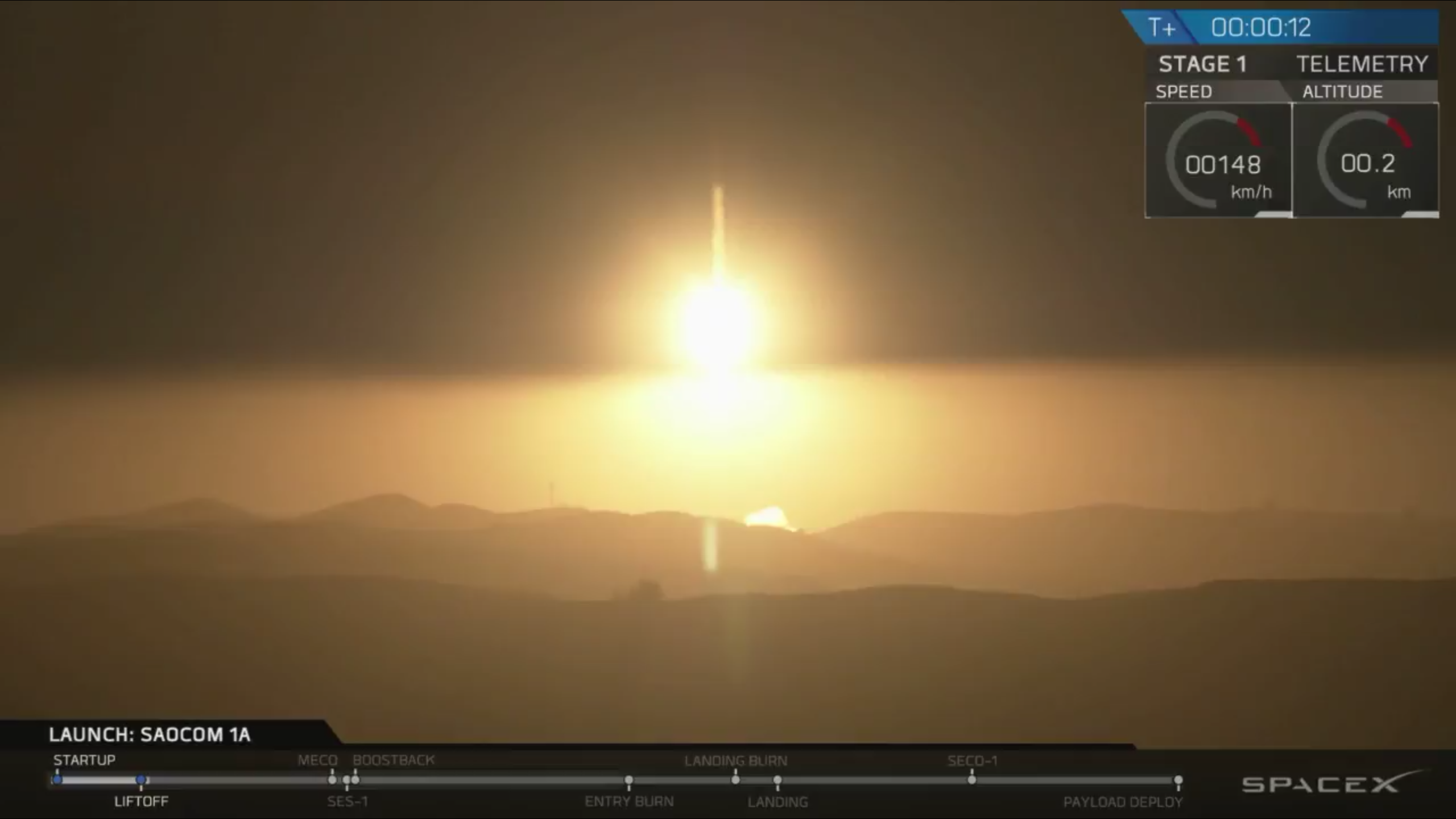
SpaceX has triumphantly wrapped up the first Return to Launch Site (RTLS) of a Falcon 9 first stage at Vandenberg Air Force Base, Calif., following the early-evening flight of Argentina’s long-awaited SAOCOM-1A radar-imaging satellite on Sunday, 7 October. Liftoff of the reused booster—which previously saw service to deliver ten Iridium NEXT global mobile communications satellites into orbit in July—took place from Space Launch Complex (SLC)-4E at 7:21 p.m. PDT.
07:46 later, in scenes previously only seen at Cape Canaveral Air Force Station, Fla., the first stage returned to a smooth touchdown on solid ground at Vandenberg. The landing occurred on SpaceX’s Landing Zone (LZ)-4, which sits on land formerly occupied by Space Launch Complex (SLC)-4W, a location used for 93 Atlas-Agena and Titan rocket launches between July 1963 and October 2003. With tonight’s launch, 2018 is shaping up to be SpaceX’s busiest-ever year on the West Coast, with five missions already flown and more on the books before December.
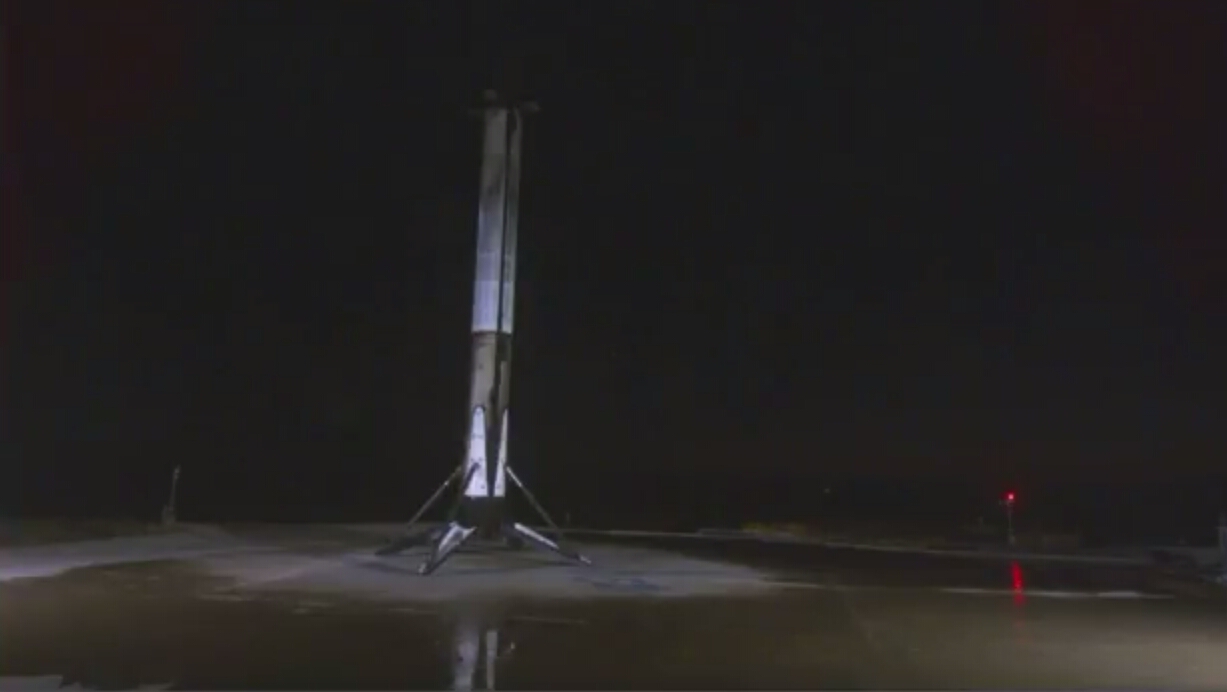
SpaceX did not attempt a payload fairing recovery for SAOCOM-1A.
Tonight’s flight was the fifth launch out of Vandenberg for SpaceX in 2018, tying with the company’s achievement from last year. To date, Spain’s Paz radar-imaging satellite was launched in February, together with three batches of Iridium NEXT satellites in March, May and July, as well as NASA’s Gravity Recovery and Climate Experiment Follow-On (GRACE-FO) twins. Yet the final weeks of 2018 offer to make this year the busiest to date for SpaceX from Vandenberg, with the final set of Iridium NEXT satellites scheduled for November, marking the 80th launch off SLC-4E in more than five decades of operational service.
The SAOCOM twins—the acronym denotes Satélite Argentino de Observación COn Microondas, Spanish for Argentine Microwaves Observation Satellite—have been waiting in the wings for almost a decade to launch. According to the government-owned INVAP aerospace corporation, which built the identical satellites on behalf of Argentina’s Comisión Nacional de Actividades Espaciales (CoNAE), the SAOCOM project got underway in 2007 and construction began three years later. Launch contracts between CoNAE and SpaceX were inked way back in April 2009, with launches of SAOCOM-1A and 1B originally targeted about a year apart in 2010-2011, but the missions have met with significant delay. Finally, in April 2016, integration of the satellites commenced and in October 2017 SAOCOM-1A entered environmental testing in the Thermovacuum Chamber of the High Technology Test Center in Bariloche, within Argentina’s Río Negro province.
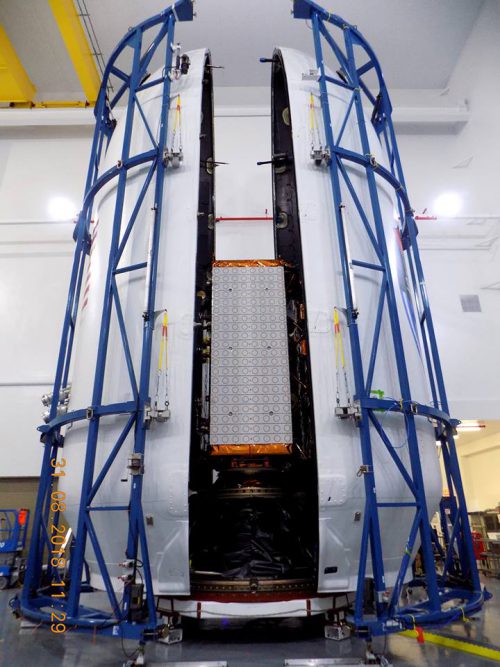
Two months later, in December 2017, the “satellite service platform”—SAOCOM-1A’s spacecraft “bus”—was declared structurally complete and its thermal blankets were installed. Electrical and mechanical validations concluded in January 2018 and in late July the satellite departed Argentina, bound for Vandenberg Air Force Base. All told, elements of the satellite came from all over Argentina: the spacecraft bus itself from Bariloche, the solar panels from Buenos Aires and the the giant Synthetic Aperture Radar (SAR) antenna from Córdoba. In May 2018, the ground segment in Córdoba completed a qualification review, demonstrating its capacity to contact and command SAOCOM-1A, as well as receiving, processing, storing and making available the data from more than 200 images per day when the satellite enters operational service.
SAOCOM is an international mission to image the Home Planet with powerful, L-band (1.275 GHz) SAR. The program folds into the joint Italian-Argentine Sistema Italo Argentino de Satélites para la Gestión de Emergencias (SIASGE) emergency management network, which also involves collaboration with NASA and the European, Italian and Canadian space agencies. SIASGE system will comprise at least ten satellites, with four Italian-built birds—the COSMO-SkyMed X-band SAR imaging platforms—already lofted aboard Delta II boosters from Vandenberg between June 2007 and November 2010. It is anticipated that, after SAOCOM-1A and 1B, two COSMO-SkyMed Second-Generation (CSG) satellites will be launched to join the SIASGE constellation later this decade, followed by a further pair of Argentine satellites (SAOCOMs 2A and 2B) in the early-mid 2020s. Operating alongside the already-in-orbit COSMO-SkyMed quartet, SAOCOM-1A will permit a twice-daily coverage capability, generating SAR products in both X-band and L-band for customers.
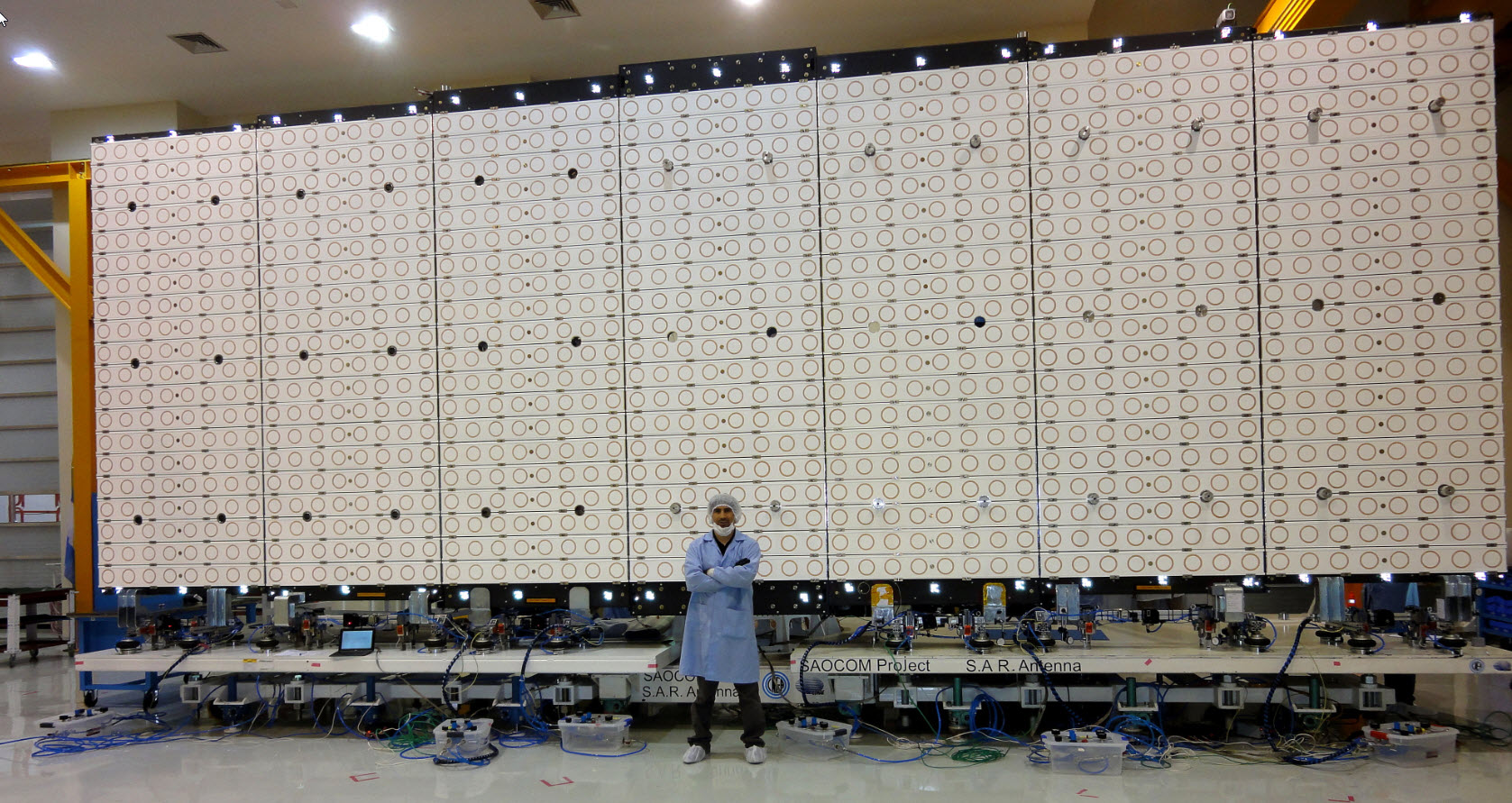
Each high-capacity SAOCOM satellite weighs around 3,500 pounds (1,600 kg)—the largest of their kind ever built in the Southern Hemisphere—and is dominated by the large L-band (1.275 GHz) full polarimetric radar antenna. This steerable, seven-paneled unit, which measures 33 feet (10 meters) in length and some 11.5 feet (3.5 meters) wide, will emit high-powered microwave pulses to conduct all-weather observations of the Home Planet, as part of efforts to mitigate the effects of natural disasters.
The SAOCOM twins will be able to detect objects larger than about 23 feet (7 meters) across, with a “swath” range of 30-250 miles (50-400 km), and their infrared cameras will scrutinize the landscape “to prevent fire in deserted areas”. Data-storage will be achieved through SAOCOM-1A’s high-capacity solid-state recorder, capable of handling 50-100 Gbits, and a high-bitrate downlink system, which comprises two 155 Mbit/sec X-band channels. A large solar array provides 2.5 kilowatts of electrical power. The main ground station at Falda del Carmen in Argentina’s central Province of Córdoba will be responsible for tracking, telemetry and control of SAOCOM-1A and for the principal downloading of its L-band SAR data. Providing additional support, via the SIASGE program, will be Telespazio’s Matera ground station in southern Italy.
When fully operational, SAOCOM-1A will support soil-moisture mapping—which carries significant hydrological implications in terms of flood-control, agriculture, climate-monitoring and human health—and, more broadly, terrain-modeling, measurements of terrain displacement and volcanology. The socio-economic needs of this mission include better understanding the characteristics of the low, flat lands of Argentina’s central Pampas region, which supports the cultivation of soybean, wheat, corn and sunflower, as well as sorghum, barley and potatoes. It is also a major cattle-rearing area. SAOCOM-1A data will be assimilated into crop-growing models to obtain improved soil-moisture profiles and better hydrological forecasts for agricultural applications.
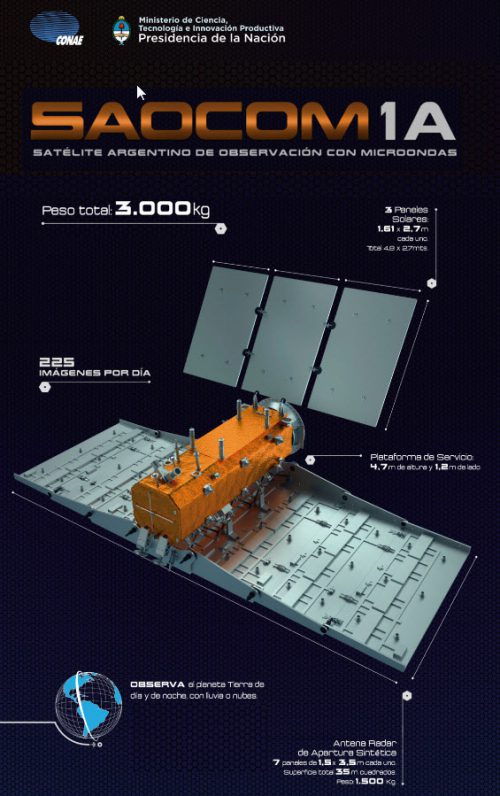
Last month, Reuters noted that the arrival of SAOCOM-1A cannot come too soon for the long-suffering Argentine economy, whose peso has devalued in recent months and the country endured a drought earlier in 2018 which sapped grain exports. Although the mission is expected to yield a five-to-seven-dollar return on every one of its reported $600 million invested, SAOCOM-1A is not expected to enter active service for several months. “Farmers depend on these satellites to ensure good crop yields,” explained German Heinzenknect, a weather specialist at the Applied Climate Consultancy, quoted by Reuters, “but given that this won’t become operative until June 2019, there is little it can do to help Argentina’s current economic situation.”
Following SAOCOM-1A’s arrival at Vandenberg, earlier this summer, preparations have entered high gear and on 14 September CoNAE added a series of images to its Facebook page, as the satellite was encapsulated within the Upgraded Falcon 9 payload fairing. In the meantime, work on the booster itself—B1048, which represents the second Block 5 first stage to be reused—continued and a Static Fire Test of the nine Merlin 1D+ engines was conducted on SLC-4E on 2 October. Following the test, the booster was taken back to the horizontal integration facility, the payload fairing was added and it was returned to the pad. It was confirmed “vertical” late Saturday night.
Liftoff at the cusp of twilight on Sunday was exceptionally smooth, as SpaceX executed its 17th launch of 2018, placing the Hawthorne, Calif.-headquartered organization in pole position to eclipse its “personal best” of 18 launches, achieved in 2017. Nine minutes after departing SLC-4E, in a blazing fireshow, the first stage returned smoothly to a touchdown on solid ground at LZ-4. Although such landings have become relatively commonplace on the East Coast—with first-stage boosters having alighted at Cape Canaveral Air Force Station, Fla., on no fewer than 11 occasions since December 2015—tonight represented the first occasion that the event had been replicated on the West Coast.
FOLLOW AmericaSpace on Facebook and Twitter!
.




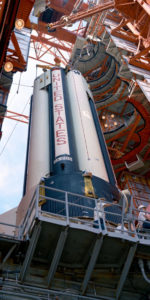
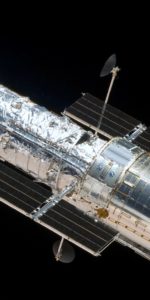
One Comment
One Ping
Pingback:SpaceX Lofts Indonesian Satellite, Sends First Private Spacecraft to Land on the Moon « AmericaSpace